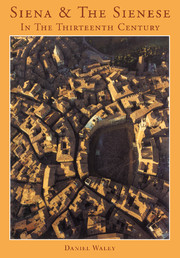Book contents
- Frontmatter
- Contents
- List of illustrations
- List of tables
- Preface
- Acknowledgements
- Glossary
- Abbreviations
- Chronology of principal political events and developments
- 1 Siena
- 1 Setting
- 2 People
- 3 Institutions
- 4 Oligarchy
- 5 Problems
- 6 Religion
- 7 Assumptions
- 8 Revenue
- 9 Expenditure
- 10 Continuity and change
- General Index
- Index of personal names
- Index of places
7 - Assumptions
Published online by Cambridge University Press: 03 December 2009
- Frontmatter
- Contents
- List of illustrations
- List of tables
- Preface
- Acknowledgements
- Glossary
- Abbreviations
- Chronology of principal political events and developments
- 1 Siena
- 1 Setting
- 2 People
- 3 Institutions
- 4 Oligarchy
- 5 Problems
- 6 Religion
- 7 Assumptions
- 8 Revenue
- 9 Expenditure
- 10 Continuity and change
- General Index
- Index of personal names
- Index of places
Summary
Some aspects of the ways of thought and life of the thirteenth-century Sienese may strike an observer in the late twentieth century as particularly unexpected or particularly surprising. Which these routines, suppositions or attitudes are, depends, naturally, on the viewpoint or expectation of the observer, hence it is not entirely correct to label what surprises us as ‘assumptions’ or presuppositions. However, since they are important features of Italian medieval civic society and were taken for granted by the medieval Sienese as aspects of their way of life which would not have required explanation or justification to their own contemporaries, it may be acceptable to consider them under the title given to this chapter. It will comprise two main sections; first the advanced bureaucratization of the commune (and the city's other institutions) and the very striking degree of intervention in all aspects of life that this made possible; secondly, the emphasis given to display, pageantry and visual aspects of authority and government.
BUREAUCRACY
The strength, extent and ramifications of Sienese bureaucracy have already been indicated in connection with the commune's institutions. The insistence that the chancery should retain copies of all letters despatched and preserve all relevant deeds, while also adding copies of them to the cartularies of privileges, sets the tone for an intensely literate mode of government characterized by a spectacular consumption of paper, parchment and ink.
- Type
- Chapter
- Information
- Siena and the Sienese in the Thirteenth Century , pp. 155 - 167Publisher: Cambridge University PressPrint publication year: 1991

